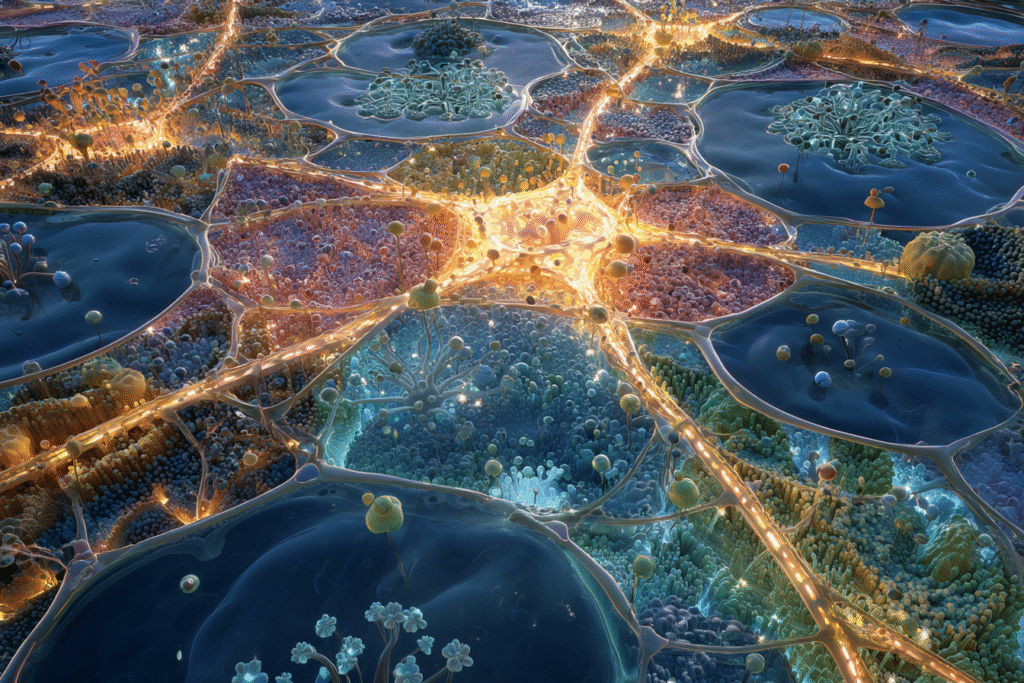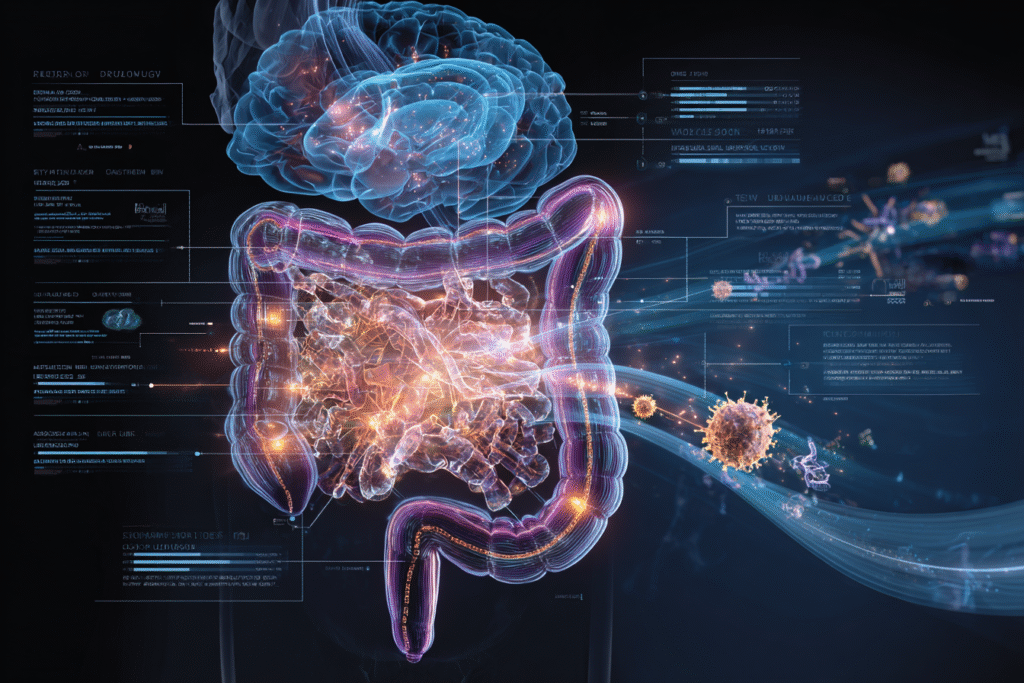Your bacteria have been orchestrating your thoughts since before you could think.
Note: This article is for educational and informational purposes only. See full disclaimer at the end.
Your gut contains 500 million neurons—more than your spinal cord.
This “second brain” produces 90% of your body’s serotonin and directly communicates with your head brain through pathways that would make the internet jealous.
But here’s what most people miss: this conversation is largely orchestrated by trillions of microorganisms whose chemical messages can determine whether you feel anxious or calm, focused or foggy, energized or exhausted.
This is the microbiome-gut-brain axis—where bacteria write the scripts for your thoughts and your thoughts rewrite their biology.
To understand how this microbial influence works, we need to explore the biological network through which your gut and brain constantly communicate.
The Microbial Internet Inside You
Every morning, before you check your first notification, your microbiome has already sent billions of chemical messages that influence your mood, energy, and cognitive capacity for the entire day [1]. The microbiota-gut-brain axis represents bidirectional communication between the gut microbiome and central nervous system through neural, endocrine, immune, and metabolic pathways. Think of it as a biological internet running on chemical protocols you never learned about.

The communication operates through four primary channels that function simultaneously, creating a constant dialogue between your microbial communities and your brain:
- The Vagus Nerve Superhighway: Direct neural pathways transmitting microbial signals faster than conscious thought [2]
- Chemical Messengers: Neurotransmitters like serotonin, dopamine, and GABA produced by gut bacteria in pharmaceutical quantities [3]
- Immune System Intermediaries: Microbial products modulating immune responses that directly affect neuroinflammation and brain function
- Metabolite Highways: Short-chain fatty acids like butyrate and propionate crossing the blood-brain barrier to influence neural activity [4]
Stanford research tracking 86 people for six years revealed that the bacteria most particular to an individual were also the most stable over time, suggesting your unique microbial fingerprint maintains consistent influence over your biological systems throughout your life [5]. This stability means that understanding your microbiome isn’t a temporary optimization strategy—it’s learning the fundamental operating system that governs your daily experience.
The implications extend far beyond digestive health. Your microbiome influences decision-making capacity, stress resilience, sleep quality, and even personality traits through mechanisms that science is only beginning to understand. When you experience an unexplained shift in mood or energy, when focus becomes elusive or anxiety increases without obvious cause, the answer often lies in the bacterial communities that call your gut home.
The Bacterial Pharmacy in Your Intestines
Your microbiome operates as a pharmaceutical manufacturing facility that produces compounds requiring prescriptions if synthesized in laboratories. This internal pharmacy operates 24 hours daily, adjusting production based on dietary inputs, stress levels, sleep patterns, and environmental factors [6].
Bacterial fermentation produces approximately 500-600 millimoles of short-chain fatty acids daily:
- Acetate (60%): Primary fuel for various tissues and metabolic processes
- Propionate (20%): Activates neural circuits controlling metabolism and appetite regulation [9]
- Butyrate (20%): Crosses the blood-brain barrier to directly influence neural metabolism [8]
These percentages shift based on dietary fiber sources, bacterial community composition, and individual genetic factors that determine how efficiently different bacterial strains process various substrates [7].

Butyrate, one of the most critical microbial metabolites, serves as the primary energy source for intestinal cells and also crosses the blood-brain barrier to influence neural metabolism directly. It acts as an epigenetic regulator—modifying gene expression in brain tissue—and provides neuroprotective benefits by reducing neuroinflammation while supporting brain cell maintenance and growth [8].
Propionate activates neural circuits controlling metabolism and appetite regulation while promoting glucagon-like peptide-1 secretion for blood glucose control [9]. Its production correlates with specific bacterial communities, enabling targeted dietary interventions that increase propionate levels for individuals with metabolic challenges or cognitive performance goals.
The neurotransmitter manufacturing capacity of gut microbes rivals that of the brain itself. Certain bacterial strains produce acetylcholine, catecholamines, GABA, histamine, melatonin, and serotonin—essential molecules for regulating mood, sleep, and cognitive function [10]. Your bacteria literally brew the chemistry of consciousness, adjusting production based on factors ranging from meal timing to stress exposure.
This internal pharmaceutical system responds to inputs faster than any external intervention. A single meal can shift bacterial metabolism within hours, altering neurotransmitter production and metabolite levels that influence brain function throughout the following day. Understanding this responsiveness opens possibilities for real-time optimization that surpasses traditional approaches to mental and physical performance enhancement.
Reading Your Microbial Messages
Your microbiome communicates through patterns that require no special equipment to interpret—only the awareness to recognize signals you may have previously attributed to other causes [11]. Unlike blood tests that capture momentary snapshots, microbial communication operates through observable patterns that reveal the health and functionality of your bacterial communities.
Digestive Communication:
- Transit time variations indicate microbial community changes
- Bloating patterns reveal fermentation activity levels
- Energy fluctuations after meals suggest metabolic efficiency
Mood and Cognitive Indicators:
- Mental health symptoms often correlate with gut microbiome alterations [12]
- Brain fog frequency can indicate neuroinflammation from microbial imbalances
- Sleep quality changes reflect microbiome influences on circadian rhythms
Immune System Responses:
- Seasonal illness susceptibility reveals immune-microbiome interactions
- Inflammation markers in skin and joints indicate systemic microbial effects
- Recovery speed from stress suggests microbiome resilience
Advanced microbiome analysis through AI-powered testing provides molecular-level insights into bacterial communities, functional capacity, and personalized optimization strategies. Companies utilizing shotgun metagenomic sequencing identify all organisms down to strain level, including bacteria, viruses, fungi, and parasites, then analyze this data against hundreds of thousands of research studies to provide personalized insights [13].

These analyses reveal strain-level bacterial identification, which proves critical since different strains of the same species can affect health differently. Functional capacity analysis shows what your specific microbes can produce, enabling targeted interventions. Personalized dietary recommendations based on your unique microbial ecology often differ significantly from generic nutritional advice, while targeted probiotic and prebiotic suggestions address your specific community needs rather than applying broad-spectrum approaches.
The Cultural Microbiome Legacy
Traditional fermented foods represent 8,000 years of cultural evolution that unknowingly optimized microbiome health across diverse populations and environments [14]. Every culture developed fermentation practices that supported beneficial bacteria, preserved nutrients, and enhanced digestibility—achievements that modern science validates with molecular precision.
Asian Fermentation Mastery:
- Kimchi and fermented vegetables providing diverse lactobacilli strains
- Miso and tempeh delivering beneficial fungi and bacterial combinations
- Traditional kefir grains maintaining complex microbial ecosystems across generations
European Dairy Innovation:
- Traditional cheese production yielding unique bacterial strains like Lactobacillus helveticus
- Sourdough cultures maintaining stable bacterial-yeast partnerships
- Fermented dairy products providing tested probiotic organisms
African Grain Fermentation:
- Sorghum and millet fermentations creating unique bacterial profiles
- Traditional brewing processes developing diverse microbial communities
- Fermented porridges providing nutrition and beneficial microbes without refrigeration
Stanford research demonstrated that 10 weeks of increased fermented food consumption significantly boosted microbiome diversity and reduced inflammatory markers, validating ancient practices with modern scientific methodology [15]. The study revealed that fermented foods provided more consistent microbiome benefits than fiber supplementation alone, suggesting that traditional preparation methods optimize bacterial delivery and survival through the digestive system.

The cultural wisdom embedded in fermentation practices often exceeds modern understanding of microbiome optimization. Traditional timing, preparation methods, and food combinations frequently demonstrate scientific principles that researchers are only beginning to explain. This suggests that incorporating traditional fermented foods provides not only beneficial bacteria but also delivery systems optimized through millennia of cultural experimentation.
AI as a Microbial Oracle
Artificial intelligence is transforming microbiome science from passive description to active prediction.
Artificial intelligence transforms microbiome analysis from descriptive observation to predictive optimization, processing vast datasets to identify patterns invisible to traditional analysis methods [16]. Machine learning algorithms now analyze microbiome data at scales and speeds that enable personalized interventions previously impossible with conventional research approaches.
Pattern recognition capabilities allow AI systems to identify connections between bacterial communities and health outcomes across populations numbering in the hundreds of thousands. These analyses reveal relationships between specific bacterial strains and cognitive performance, mood stability, immune function, and metabolic health that individual studies could never detect due to sample size limitations.
Digital twin technology simulates the impact of various foods, dietary changes, and interventions on individual gut microbiomes before implementation [17]. These models predict which specific probiotics and prebiotics will benefit particular microbial communities, eliminating the trial-and-error approach that characterizes most microbiome interventions. Machine learning identifies optimal timing and dosing for microbiome interventions based on individual patterns and responses.
The real power of these AI advances emerges when sophisticated analysis translates into practical, everyday applications.

From Insights to Action
What used to be complex lab work is now accessible to everyday users through AI-powered apps, wearables, and personalized reports.
Clinical applications include AI-driven identification of disease biomarkers and therapeutic targets within microbiome data. Predictive modeling forecasts microbiome responses to dietary changes with increasing accuracy, while automated analysis reduces the complexity of interpreting multi-omics data that includes bacterial genetics, metabolite production, and host immune responses.
Consumer applications increasingly leverage AI for practical microbiome optimization. Platforms analyze individual microbiome data against extensive research databases to provide personalized recommendations that evolve based on ongoing monitoring and feedback. Apps track fermented food intake and correlate consumption patterns with health outcomes, identifying optimal foods and timing for individual biology.
The integration of wearable devices with microbiome data creates comprehensive pictures of how bacterial communities influence and respond to sleep, exercise, stress, and dietary patterns. This real-time feedback enables adjustments that optimize both immediate symptoms and long-term microbiome health through data-driven decision making.
Building Your Gut-Brain Partnership
Optimizing microbiome-brain communication requires systematic approaches that combine observation, intervention, and optimization based on individual responses and patterns [18].

The most effective strategies integrate traditional fermentation wisdom with modern monitoring and AI-powered insights.
Phase 1: Baseline Assessment (Weeks 1-2)
- Document daily energy patterns and mood fluctuations
- Record digestive comfort, regularity, and timing patterns
- Track sleep quality and cognitive clarity relationships to diet
- Consider AI-powered microbiome analysis for detailed insights
Phase 2: Diversity Enhancement (Weeks 3-6)
- Increase fermented food variety gradually, aiming for 2-3 servings daily
- Include diverse fiber sources to feed beneficial bacteria
- Rotate fermented foods weekly to introduce different microbial strains
- Experiment with traditional fermented foods from different cultures
Phase 3: Targeted Optimization (Weeks 7-12)
- Adjust interventions based on observed responses and patterns
- Focus on fermented foods demonstrating clear individual benefits
- Consider targeted probiotics for specific health objectives
- Align microbiome support with stress management and seasonal variations
The Mood-Microbiome Connection
Research consistently demonstrates relationships between gut microbiome composition and neuropsychiatric conditions including depression, anxiety, and neurodegenerative diseases, though causality operates bidirectionally [19]. Understanding these connections enables interventions that support both bacterial communities and mental health through integrated approaches.
Practical mood-microbiome optimization begins with morning rituals that signal beneficial bacteria while supporting stable mood patterns. Begin days with fermented foods to provide bacterial support and metabolic substrates. Include prebiotic fiber to support microbial metabolism throughout the day. Maintain consistent timing for circadian microbiome rhythms that influence sleep-wake cycles and hormone production.

Stress management requires recognizing that psychological stress directly modulates microbiota composition while bacterial imbalances can increase stress sensitivity [20]. Practice stress reduction techniques that support microbial balance, including meditation, exercise, and social connection. Use fermented foods as both nutritional support and stress management tools, recognizing their dual roles in biological and psychological well-being.
Evening optimization supports microbiome-produced melatonin through appropriate food timing and choices. Allow digestive rest to enable microbiome maintenance activities that occur during sleep. Create environments supporting both mental and microbial restoration through stress reduction, appropriate lighting, and sleep hygiene practices.
The bidirectional nature of mood-microbiome relationships means that improving either component supports the other. Mental health practices that reduce stress and improve sleep quality create environments where beneficial bacteria thrive. Simultaneously, microbiome support through fermented foods and stress management often improves mood resilience and cognitive function through bacterial metabolite production.
Beyond the Gut: Systemic Integration
The microbiome influences every biological system through mechanisms that extend far beyond digestive health [21]. Understanding these systemic connections reveals why microbiome optimization affects energy, immunity, cardiovascular health, and cognitive performance through integrated biological networks.
Metabolic connections include short-chain fatty acid regulation of glucose homeostasis, lipid metabolism, and appetite control. Microbial metabolites influence insulin sensitivity and energy storage patterns while bacterial communities affect weight management and metabolic health through mechanisms that operate independently of caloric intake. The relationship between microbiome diversity and metabolic flexibility suggests that bacterial communities determine how efficiently bodies adapt to different energy sources and demands.

Immune system modulation occurs through microbiome-immune crosstalk that regulates inflammation throughout the body. Beneficial bacteria train immune responses and maintain tolerance to harmless substances while supporting appropriate responses to genuine threats. Microbial diversity supports immune system resilience and reduces autoimmune tendencies through mechanisms that balance immune activation and regulation.
Cardiovascular health benefits include short-chain fatty acid provision of cardiovascular protection through reduced atherosclerosis and direct heart health support. The microbiome influences blood pressure regulation through bacterial metabolite effects on blood vessel function. Bacterial metabolites affect cholesterol metabolism and inflammatory markers that determine cardiovascular disease risk independent of traditional risk factors.
These systemic effects demonstrate why microbiome optimization often produces improvements in multiple health areas simultaneously. Supporting beneficial bacterial communities creates cascade effects that enhance biological function across interconnected systems rather than targeting isolated symptoms or conditions.
The Future of Microbiome Medicine
The convergence of artificial intelligence and ancient fermentation wisdom creates unprecedented opportunities for personalized health optimization that honors both traditional knowledge and technological advancement [22]. This integration suggests future approaches that combine cultural heritage with precision medicine for optimal outcomes.
Precision microbiome medicine will include AI-guided probiotic selection based on individual microbial profiles and health goals. Personalized fermented food recommendations will consider specific bacterial communities, genetic factors, and lifestyle patterns. Real-time microbiome monitoring with immediate intervention suggestions will enable responsive optimization that adapts to changing conditions and needs.

Cultural integration approaches will preserve traditional fermentation knowledge while enabling scientific analysis of bacterial communities and health effects. Global fermented food databases will connect traditional practices with modern understanding of bacterial benefits. Community-based microbiome health initiatives will combine cultural wisdom with technological tools for population-level optimization.
Therapeutic applications include next-generation bacteria showing potential for treating obesity, liver disease, and mental health conditions through targeted bacterial interventions. Microbiome-based treatments for neurological conditions will leverage gut-brain axis communication for therapeutic benefit. Preventive medicine approaches based on microbial risk assessment will enable early interventions that maintain health rather than treating disease.
The Neverending Conversation
The conversation between your gut and brain never stops.
Every meal, every stress response, every moment of rest influences this ancient dialogue that shapes your daily experience. By understanding and supporting this communication network, you optimize not just your microbiome but the biological operating system that runs your entire life.
Your bacteria have been taking care of you since birth. The question isn’t whether to work with them—it’s how consciously you choose to participate in this partnership that defines your health, mood, and cognitive capacity every single day.
If your second brain runs your first brain, what happens when you consciously participate in their conversation?
See you in the next insight.
Comprehensive Medical Disclaimer: The insights, frameworks, and recommendations shared in this article are for educational and informational purposes only. They represent a synthesis of research, technology applications, and personal optimization strategies, not medical advice. Individual health needs vary significantly, and what works for one person may not be appropriate for another. Always consult with qualified healthcare professionals before making any significant changes to your lifestyle, nutrition, exercise routine, supplement regimen, or medical treatments. This content does not replace professional medical diagnosis, treatment, or care. If you have specific health concerns or conditions, seek guidance from licensed healthcare practitioners familiar with your individual circumstances.
References
To aid interpretation, references are annotated by source type. Academic sources form the core evidence base, while institutional and industry perspectives offer supplementary insights.
Peer-Reviewed/Academic Sources
- [1] Cryan, J. F., & Dinan, T. G. (2012). Mind-altering microorganisms: the impact of the gut microbiota on brain and behaviour. Nature Reviews Neuroscience, 13(10), 701-712. https://www.nature.com/articles/nrn3346
- [2] Mayer, E. A., Tillisch, K., & Gupta, A. (2015). Gut/brain axis and the microbiota. Journal of Clinical Investigation, 125(3), 926-938. https://www.jci.org/articles/view/76304
- [3] Silva, Y. P., Bernardi, A., & Frozza, R. L. (2020). The role of short-chain fatty acids from gut microbiota in gut-brain communication. Frontiers in Endocrinology, 11, 25. https://www.frontiersin.org/articles/10.3389/fendo.2020.00025/full
- [4] Chambers, E. S., Preston, T., Frost, G., & Morrison, D. J. (2018). Role of gut microbiota-generated short-chain fatty acids in metabolic and cardiovascular health. Current Nutrition Reports, 7(4), 198-206. https://link.springer.com/article/10.1007/s13668-018-0248-8
- [5] Zhou, X., et al. (2024). Our bacteria are more personal than we thought, Stanford Medicine-led study shows. Stanford Medicine News. https://med.stanford.edu/news/all-news/2024/03/personal-microbiome.html
- [6] Stilling, R. M., van de Wouw, M., Clarke, G., Stanton, C., Dinan, T. G., & Cryan, J. F. (2016). The neuropharmacology of butyrate: The bread and butter of the microbiota-gut-brain axis? Neurochemistry International, 99, 110-132. https://pubmed.ncbi.nlm.nih.gov/27346602/
- [7] Koh, A., De Vadder, F., Kovatcheva-Datchary, P., & Bäckhed, F. (2016). From dietary fiber to host physiology: short-chain fatty acids as key bacterial metabolites. Cell, 165(6), 1332-1345. https://www.sciencedirect.com/science/article/pii/S009286741630592X
- [8] Bourassa, M. W., Alim, I., Bultman, S. J., & Ratan, R. R. (2016). Butyrate, neuroepigenetics and the gut microbiome: Can a high fiber diet improve brain health? Neuroscience Letters, 625, 56-63. https://pubmed.ncbi.nlm.nih.gov/26868600/
- [9] Stilling, R. M., et al. (2022). Predicting butyrate- and propionate-forming bacteria of gut microbiota from sequencing data. Gut Microbes, 14(1), 2149019. https://www.tandfonline.com/doi/full/10.1080/19490976.2022.2149019
- [10] Yano, J. M., et al. (2015). Indigenous bacteria from the gut microbiota regulate host serotonin biosynthesis. Cell, 161(2), 264-276. https://www.ncbi.nlm.nih.gov/pmc/articles/PMC4393509/
- [11] Carabotti, M., Scirocco, A., Maselli, M. A., & Severi, C. (2015). The gut-brain axis: interactions between enteric microbiota, central and enteric nervous systems. Annals of Gastroenterology, 28(2), 203-209. https://www.ncbi.nlm.nih.gov/pmc/articles/PMC4367209/
- [12] Foster, J. A., & Neufeld, K. A. M. (2013). Gut-brain axis: how the microbiome influences anxiety and depression. Trends in Neurosciences, 36(5), 305-312. https://www.cell.com/trends/neurosciences/fulltext/S0166-2236(13)00008-8
- [13] Pasolli, E., et al. (2019). Extensive unexplored human microbiome diversity revealed by over 150,000 genomes from metagenomes spanning age, geography, and lifestyle. Cell, 176(3), 649-662. https://www.sciencedirect.com/science/article/pii/S0092867419300017
- [14] Tamang, J. P., Watanabe, K., & Holzapfel, W. H. (2016). Review: Diversity of microorganisms in global fermented foods and beverages. Frontiers in Microbiology, 7, 377. https://www.frontiersin.org/articles/10.3389/fmicb.2016.00377/full
- [15] Wastyk, H. C., et al. (2021). Gut-microbiota-targeted diets modulate human immune status. Cell, 184(16), 4137-4153. https://www.cell.com/cell/fulltext/S0092-8674(21)00754-6
Industry/Technology Sources
- [16] Quince, C., Walker, A. W., Simpson, J. T., Loman, N. J., & Segata, N. (2017). Shotgun metagenomics, from sampling to analysis. Nature Biotechnology, 35(9), 833-844. https://www.nature.com/articles/nbt.3935
- [17] Abavisani, M., et al. (2024). Deciphering the gut microbiome: The revolution of artificial intelligence in microbiota analysis and intervention. Current Research in Biotechnology, 7, 100376. https://www.sciencedirect.com/science/article/pii/S2590262824000376
- [18] Marco, M. L., et al. (2017). Health benefits of fermented foods: microbiota and beyond. Current Opinion in Biotechnology, 44, 94-102. https://www.sciencedirect.com/science/article/abs/pii/S095816691630266X
- [19] Morais, L. H., Schreiber, H. L., & Mazmanian, S. K. (2021). The gut microbiota–brain axis in behaviour and brain disorders. Nature Reviews Microbiology, 19(4), 241-255. https://www.nature.com/articles/s41579-020-00460-0
- [20] Madison, A., & Kiecolt-Glaser, J. K. (2019). Stress, depression, diet, and the gut microbiota: human–bacteria interactions at the core of psychoneuroimmunology and nutrition. Current Opinion in Behavioral Sciences, 28, 105-110. https://www.sciencedirect.com/science/article/abs/pii/S2352154618301608
- [21] Levy, M., Kolodziejczyk, A. A., Thaiss, C. A., & Elinav, E. (2017). Dysbiosis and the immune system. Nature Reviews Immunology, 17(4), 219-232. https://www.nature.com/articles/nri.2017.7
- [22] Bzdok, D. (2017). Classical statistics and statistical learning in imaging neuroscience. Frontiers in Neuroscience, 11, 543. https://www.frontiersin.org/articles/10.3389/fnins.2017.00543/full


